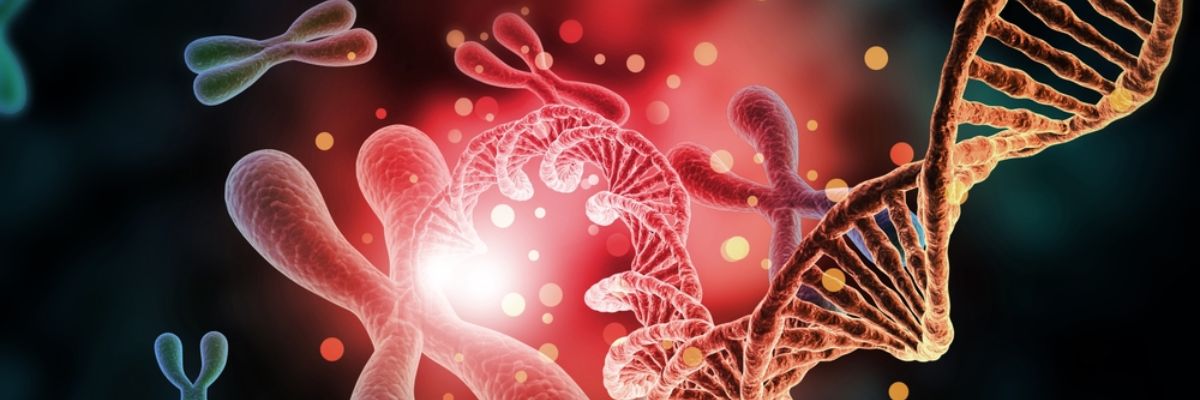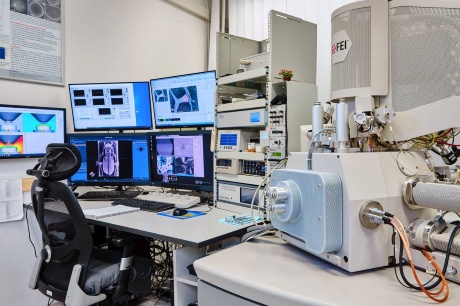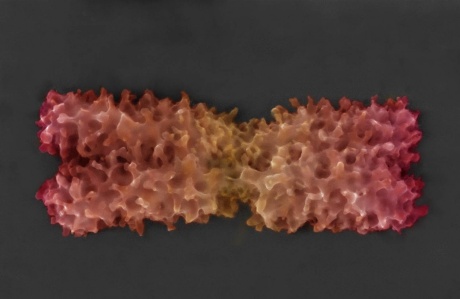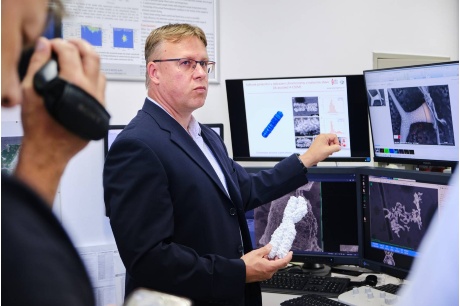
Revolutionary method pioneered by Czech scientists reveals chromosome structure
02. 08. 2024
In 1842, Swiss botanist Carl Wilhelm von Nägeli was the first to observe and describe chromosomes. Since then, research in genetics and imaging techniques has taken significant leaps forward. Over 180 years later, researchers from two institutes of the Czech Academy of Sciences – the Institute of Scientific Instruments and the Institute of Experimental Botany – have achieved a similarly groundbreaking milestone. Thanks to a new imaging method, they have managed to visualize a chromosome in its native state. Revealing its surface structure, consisting of tiny protrusions and chromatin fibers spatially organized in loops, could potentially impact fields such as medicine and agriculture. The researchers introduced their new method at a press conference in Brno on 18 July 2024.
After years of research efforts all over the world to image biological samples in their native state, Czech scientists have brought forth a solution. The newly developed Advanced Environmental Scanning Electron Microscopy (A-ESEM) method opens up entirely new possibilities for studying samples of both animate and inanimate natural origin. Until recently, Scanning Electron Microscopy (SEM) was used to image the spatial ultra-structure of biological and non-biological materials at resolutions of up to one millionth of a millimeter. However, SEM requires samples to be observed in a high vacuum, which involves treatments that can damage their structure, making it impossible to observe them in their native state.
The A-ESEM imaging method allows researchers to examine practically all types of living samples: plant cells and, to some extent, animal cells in their native state, small living animals, fungi, molds, mites, protein and bacteria molecules. Scientists are also planning to study viruses. What’s more, they can monitor dynamic changes in samples due to temperature changes, drying, chemical reactions, or physical processes and stimuli.

The press conference was attended by Ilona Müllerová, Vice President of the Czech Academy of Sciences; Josef Lazar, Director of the Institute of Scientific Instruments of the CAS; plant geneticist Jaroslav Doležel; and the creator of the imaging method, Vilém Neděla.
Like a car that can turn into a submarine
“A conventional microscope can be compared to a luxury car, while an environmental scanning electron microscope is a luxury car that has been ‘tuned’ and fitted with even better specifications, so it can also drive on water and turn into a submarine. It has all the functions of a classic microscope, plus many more,” explains Vilém Neděla, head of the Environmental Electron Microscopy group at the Institute of Scientific Instruments of the CAS, which developed the method.
“We use AI-based software that advises us on how to set certain imaging parameters to avoid damaging the sample. We have utilized many of our own innovations and, thanks to ultra-sensitive detectors, we observe the samples under low-dose and high gas pressure conditions and in up to 100% humidity; that is, under environmentally compatible conditions – very carefully, without inflicting any damage on them,” Neděla notes.

Prototype of the unique electron microscope used for the A-ESEM method. Thanks to ultra-sensitive detectors, scientists can observe samples under high gas pressure conditions and in up to 100% humidity.
A–ESEM is the most versatile of all electron microscopy methods and can be used for the preparation and further physicochemical analyses of samples. According to Neděla, it is even faster, cheaper, and more suitable for studying dynamic changes in biological samples than cryo-electron microscopy, awarded the Nobel Prize in 2017. “This new method resolves the fundamental issue of the supposed incompatibility of electron microscopy with the presence of liquid water in the observed sample. That is why it is suitable for imaging living organisms and extremely sensitive nanostructures and nanosurfaces, all in high resolution,” Neděla explains.
A significant discovery for human and plant health
The potential of the new imaging method was verified by scientists in collaboration with the Institute of Experimental Botany of the CAS through the study of chromosomes – microscopic structures that store hereditary information and transfer it to daughter cells and progenies.
During cell division, chromosomes condense into microscopic, rod-like structures. Research teams all over the world have attempted to uncover the nanostructure of chromosomes for years – with no success, as all available methods to date have required drastic treatment of the samples with chemicals, drying, plating, or freezing and subsequent sublimation of ice. And because the surface layer of the chromosome is extremely sensitive, it was either damaged or completely removed during such observations.

Colored image of a chromosome in its native state obtained using the newly developed imaging A-ESEM method. The actual chromosome measures approximately five millionths of a meter. Credit: Institute of Scientific Instruments of the CAS
The idea to observe chromosomes came from plant geneticist Jaroslav Doležel, head of the research team at the Institute of Experimental Botany of the CAS. The new imaging method revealed that the surface of condensed chromosomes is dotted with numerous protrusions and loop formations of chromatin fibers, averaging about 30 nanometers in size. Such a spatial arrangement of the chromosome surface had not been observed before. Furthermore, the Czech scientists likely managed to image nucleosomes that are only 12 nm in size, onto which the DNA molecule is wound like a spool.
The results advance our understanding of the molecular nanostructure of chromosomes. “Chromosomes carry hereditary information from one cell to another. Unless we understand chromosome structure, we can’t understand how information is transferred and can’t identify any issues,” Doležel explains.
In humans, chromosomal anomalies cause genetic disorders, while in agricultural crops, they lead to reduced fertility and yield. The detailed visualization of the surface structure of chromosomes will provide new insights into the structure of the genetic apparatus, enable the identification of structural defects, and contribute to the development of synthetic organisms with artificially created genetic information.

Vilém Neděla in the lab, presenting the newly developed method to journalists.
The achievable resolution of A–ESEM when studying chromosomes is comparable to the resolution of scanning electron microscopy (SEM) in its vacuum conditions, which, according to Neděla, could have a significant impact on the global market for electron microscopes. “The possibility of combining A–ESEM with other imaging methods, including light microscopy, will allow researchers to image and functionally analyze not only chromosomes, but also other biological objects in their native state. The practical impact of the potential widespread adoption of the new A–ESEM method are currently beyond estimation. At the Institute of Scientific Instruments of the CAS, we are convinced that this is one of the most important discoveries ever made at our institution and is a revolutionary step forward for electron microscopy as a whole,” Neděla concludes.
The results were published in the journal Scientific Reports.
The new Advanced Environmental Scanning Electron Microscopy (A–ESEM) imaging method, as explained by researchers from the Institute of Scientific Instruments and Institute of Experimental Botany of the CAS, who imaged an entire chromosome in its native state:
The new Advanced Environmental Scanning Electron Microscopy (A–ESEM) imaging method, as explained by researchers from our Institute of Scientific Instruments and @UEBavcr, who imaged an entire chromosome in its native state: pic.twitter.com/qHLzvdmqlR
— Czech Academy of Sciences (@CzechAcademy) August 1, 2024
_______________
A 3D model of a chromosome:
Written and prepared by: Markéta Wernerová, External Relations Division, CAO of the CAS, drawing on the CAS press release
Translated by: Tereza Novická, External Relations Division, CAO of the CAS
Photo: Shutterstock; Institute of Scientific Instruments of the CAS
 The text is released for use under the Creative Commons license.
The text is released for use under the Creative Commons license.
Read also
- Moss as a predator? Photogenic Science reveals the beauty and humor in research
- How does the Academy Council plan to strengthen the Academy’s role? Part 2
- How does the Academy Council plan to strengthen the Academy’s role? Part 1
- Ombudsperson Dana Plavcová: We all play a role in creating a safe workplace
- ERC Consolidator Grant heads to the CAS for “wildlife on the move” project
- A little-known chapter of history: Czechoslovaks who fought in the Wehrmacht
- Twenty years of EURAXESS: Supporting researchers in motion
- Researching scent: Cleopatra’s legacy, Egyptian rituals, and ancient heritage
- The secret of termites: Long-lived social insects that live in advanced colonies
- Two ERC Synergy Grants awarded to the Czech Academy of Sciences
The Czech Academy of Sciences (the CAS)
The mission of the CAS
The primary mission of the CAS is to conduct research in a broad spectrum of natural, technical and social sciences as well as humanities. This research aims to advance progress of scientific knowledge at the international level, considering, however, the specific needs of the Czech society and the national culture.
President of the CAS
Prof. Eva Zažímalová has started her second term of office in May 2021. She is a respected scientist, and a Professor of Plant Anatomy and Physiology.
She is also a part of GCSA of the EU.